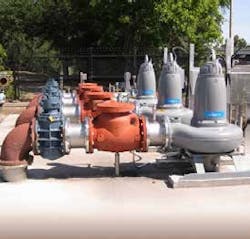JEA, formerly Jacksonsonville Electric Authority, ranks among the nation’s largest and most efficient community-owned electric, water and sewer utilities. The sewer service area now represents one of the largest geographic footprints in the nation at approximately 900 square miles. The sewer utility serves 230,000 customers and handles a 78 mgd average daily flow.
Project Background
The JEA had no reservations about approving the conversion of the traditional pump station to a booster pump station due to a chronic odor and ragging problem.
The extended detention time for the force main’s flow within the 18 mile long line created ideal conditions for the buildup of hydrogen sulfide gas in the sewage flow collected from a large portion of a growing part of the service area. This set the stage for the major odor problem when the flow reached the original pump station’s wetwell, says Bob Phillips, a JEA project engineer.
“JEA was spending $752 a day for chemicals in a futile attempt to control odor at that facility,” Phillips said.
“We were spending an additional $3400 a month for a vac-truck to clean out the blanket of floating rags and grease that accumulated in the original pump station’s wetwell.”
Solution
Although upgrading the aging odor control system would have helped to reduce the offensive emissions, the root cause of the odor, the high concentration of hydrogen sulfide in the force main’s flow, would have remained, Phillips said. Therefore, his engineering group pursued the more permanent solution of converting the pump station to a booster pump station.
JEA elected to divert the force main’s flow off the wetwell by building an above-grade booster facility in proximity to the original pumping installation. Designing the new station this way cut the required horsepower in half while still pumping the same flow. The existing 95-HP pumps and odor control equipment were pulled and replaced by 45-HP Flygt N-pumps that provide the hydraulic muscle for the new companion booster facility.
The costs associated with the ragging problem of the former pumps were resolved by the design of the award-winning Flygt N-pump developed by Xylem.
Result
The high-performance units employ a patented impeller that is both more energy and clog efficient and maintains unobstructed flow of stringy and fibrous material from building up and blocking the intake.
The fibrous residuals that reached the facility had become an even greater problem for the earlier pumps when combined with grease reaching the wetwell. Instead, the N-pumps now avoid intake obstruction by allowing both types of debris to simply pass through the intakes. The unique N-pumps handle not only the materials flushed into the collection lines but also achieve impressive energy savings.
Phillips said the conversion has proven successful and foresees the concept as applicable to other JEA installations and even other municipal operations. The investment in this retrofit was clearly justified by the numbers.
Editor's Note: Scranton Gillette Communications and the SGC Water Group are not liable for the accuracy, efficacy and validity of the claims made in this piece. The views expressed in this content do not reflect the position of the editorial teams of Water & Wastes Digest, Water Quality Products and Storm Water Solutions.
